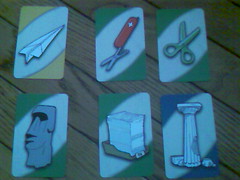 I’m a subscriber to Pyramid magazine, and some days I think the only reason I have to do so is because it’s an inexpensive, consistent flow of game news. It’s because of articles like the one I read today that I fail to fathom why I continue to pay them at all when less expensive tripe can be obtained more abundantly from many other sources.
I’m a subscriber to Pyramid magazine, and some days I think the only reason I have to do so is because it’s an inexpensive, consistent flow of game news. It’s because of articles like the one I read today that I fail to fathom why I continue to pay them at all when less expensive tripe can be obtained more abundantly from many other sources.
The article in question is available only to subscribers (sorry), but involves a game that I discovered while meandering around the exhibit floor at Origins. The game is Rock! by Out of the Box Publishing, and is one of the more interesting new card games I saw while at the game fair.
Here is the summary of what the article said about the game, Rock!, besides ranting for several paragraphs about the quality of the materials from which the game was built:
Sadly, the artwork and the tin are the best features this item has to offer. … Alas, Rock! doesn't really rise above its "source material," and the underlying game is an inexpensive way to pay too much for what amounts to a gimmick.
Not only does that make no sense (“inexpensive way to pay too much”?), but it’s outright wrong. Let me explain what Pyramid completely overlooked about this game.
Rock! is a fast card game, somewhat in the style of Out of the Box’s other popular game, Blink, which they have since sold the rights to Hasbro. The game consists simply of a deck of cards with artistic renderings of the classic components of Roshambo - rock, paper, or scissors.
The game is played by splitting the cards evenly between two players. The players simultaneously flip a card from the top of their decks onto the play surface, revealing the image on the card face. The cards are be compared mentally upon their revelation, and the winner of the standard game is known. But the person who threw the winning card of the pair is not the winner! The winner is the person who can call out the winning card first.
This seems really easy based solely on this description. It is a lot more difficult than it sounds. Consider the cards below.
You can see that discerning which item a card represents can be challenging even before trying to figure out which item wins. The images are deceiving. Some of the paper images look like they could be rocks at first glance. Some of the rocks look like they could be paper. The scissor images are all over the map. It’s definitely not as simple as having a single image for each card type, which would indeed make the game no challenge.
The first time you play it, there is a significant novelty factor. It doesn’t dawn on you that the images are going to be that difficult to discern. Even after the first play, it’s a challenge.
You can imagine that there are many false calls in the game. If you call a throw falsely, your opponent wins the set. This adds a bit of strategy to the game. Can you trust to let your opponent simply name the wrong winner? Sometimes you can!
In the case of a tied game, you flip another card. You can also flip another card if you can’t decide between the players who won a throw.
Yes, the game is pretty simple. It could be emulated by a deck of regular cards, but you’d completely lose the aspect of discerning the nature of the artwork on the card. This aspect makes the card art a requirement for the uniqueness of the game, not just an amusing bonus, as characterized by the Pyramid article.
Regarding the quality of the product, I’m not sure what the reviewer was looking for in a deck of cards. The cards are of no worse quality than the ones Out of the Box produced for Blink, which similarly to my Rock! cards, have withstood many games with adults slamming hands and children shuffling indiscriminately. The reviewer must not have played the game extensively (the rules of which don’t prescribe slapping any cards down, unlike what is written in the article), and I can’t imagine he would have given his complete disregard for the game, almost entirely based on its card stock weight and perceived lack of originality.
Rock! is a great little game, easily traveled, simple to teach to kids who already know rock-paper-scissors, and well worth the price for the quality artwork, unique game concept, and sturdy travel container.
The review is one of the shoddiest pieces of reporting I’ve seen on Pyramid, a publication that would seem to pride itself on showing the uniqueness of games. Being that I’ve based dismissal of some newer games on things I’ve read in Pyramid reviews, I’m wondering what else I’ve been missing by paying heed to such reviews.
